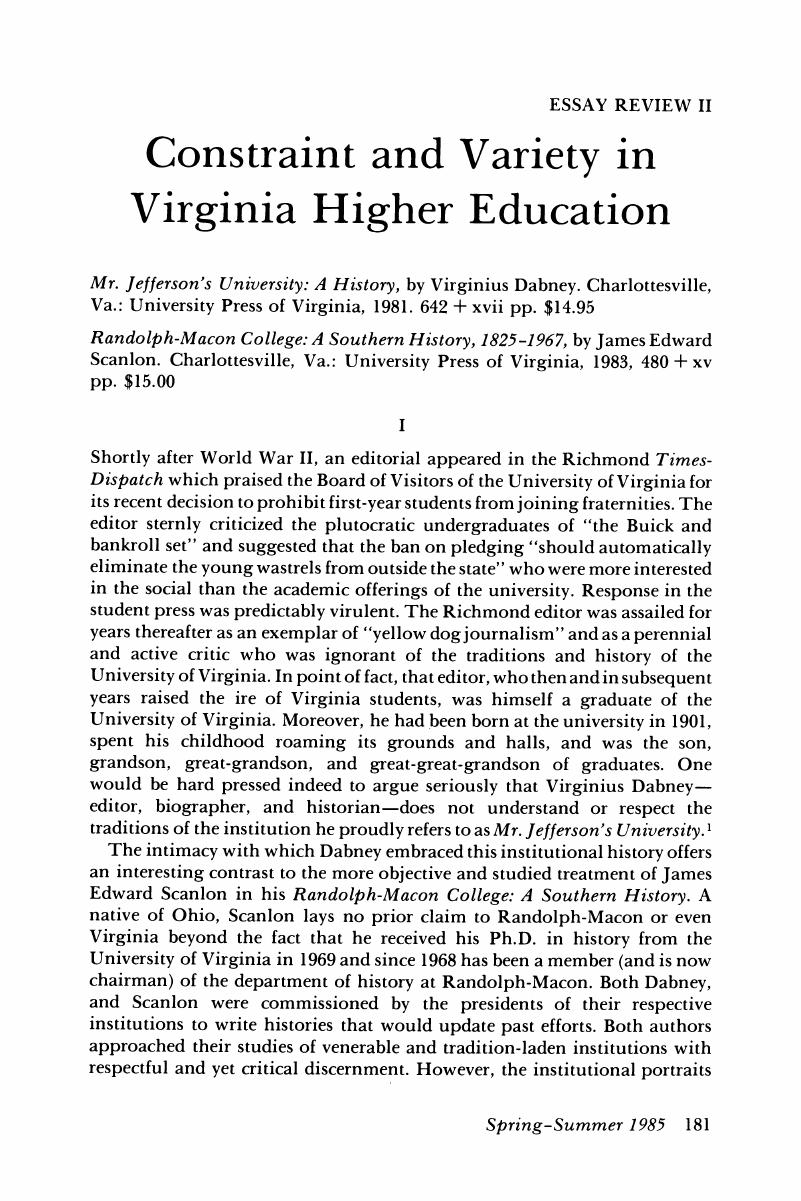No CrossRef data available.
Article contents
Constraint and Variety in Virginia Higher Education
Published online by Cambridge University Press: 24 February 2017
Abstract

- Type
- Essay Reviews
- Information
- Copyright
- Copyright © 1985 by History of Education Society
References
Notes
1. Dabney, Virginius, Mr. Jefferson's University: A History (Charlottesville, Va., 1981), p. 274 ff.Google Scholar
2. Bruce, Philip Alexander, History of the University of Virginia, 1819–1919, 5 vols. (New York, 1922).Google Scholar
3. By 1984 the endowment of the University of Virginia had surpassed the $225,000,000 mark, making it second among state universities in terms of size of endowment.Google Scholar
4. Scanlon has himself been a contributor to the dialogue. See, for example, his essay review, “American College Presidents in the Eighteenth Century,” History of Education Quarterly, 11 (Spring, 1971): 72–77.Google Scholar
5. Jefferson, Thomas to Priestly, Joseph, January 18, 1800 in Lipscomb, Andrew A. and Bergh, A.E., eds., The Writings of Thomas Jefferson (Washington, D.C., 1903), 10, p. 147.Google Scholar
6. Stephen Olin to Rev. Mr. Landon, Leicester, September 4, 1834, as quoted in Scanlon, James Edward, Randolph-Macon College: A Southern History, 1825–1967 (Charlottesville, Va., 1983), p. 20.Google Scholar
7. As attributed to John Randolph by Scanlon, , p. 21.Google Scholar
8. Olin, Stephen, Inaugural Address, … 5th March, 1834, as quoted in Scanlon, p. 56.Google Scholar
9. Alderman, Edwin A., unfootnoted quotation, n.d., as cited by Dabney, , p. 106.Google Scholar
10. University of Virginia Alumni News , ibid., p. 134.Google Scholar
11. Scanlon, , p. 330.Google Scholar
12. Shannon, Edgar F. Jr., Inaugural Address, October 6, 1959, as quoted in Dabney, p. 423.Google Scholar
13. Dabney, , p. 505.Google Scholar
14. Faulkner, William, unfootnoted quotation, n.d., as cited by Dabney, , p. 459.Google Scholar
15. Alderman, Edwin A. to Page, Walter Hines, April 4, 1904, as quoted in Vann Woodward, C., Origins of the New South: 1877–1913 (Baton Rouge, La., 1951), pp. 436–437.Google Scholar
16. The Baltimore Conference of the Church, Methodist, split by the Civil War, joined with the Virginia Conference following the war as a patron of Randolph-Macon, a college than pressed to preserve Southern ideas about liberty and religion and to form a bulwark against Northern religious as well as political reconstruction. See Scanlon, , p. 144 ff. Google Scholar
17. Blackwell, Robert E., President's Report, 1910, as quoted in Scanlon, p. 234.Google Scholar
18. Scanlon, , p. 258. Vanderbilt University, however, did have its version of a James Cannon in the personage of Bishop Warren Candler who in 1904 sparked a similar decade-long controversy regarding ownership of that institution. See Bauman, Mark K., “Confronting the New South Creed: The Genteel Conservative as Higher Educator” in Goodenow, Ronald and White, Arthur, eds., Education and the Rise of the New South (Boston, 1981).Google Scholar
19. Report of the Commissioner of Education, 1911, I, p. 255, as quoted in Woodward, p. 439.Google Scholar
20. As quoted in Francis Simkins, Butler and Roland, Charles Pierce, A History of the South, 4th Ed. (New York, 1972), p. 362.Google Scholar
21. See Wiley, Wayne Hamilton, “Academic Freedom at the University of Virginia: The First Hundred Years—From Jefferson Through Alderman.” Ph.D. Dissertation, University of Virginia, 1973.Google Scholar




